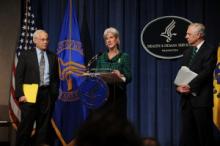Government officials have stood before doctors many times and talked about the need to change the perverse incentives that pay them more for caring for sick patients than for keeping people healthy to start. Dr. Richard Gilfillan, who runs the new Center for Medicare and Medicaid Innovation, had a similar pitch when he talked to more than 1,000 people who recently convened at a Washington, D.C. hotel for a day-long summit on health care innovation. The difference is, Dr. Gilfillan has some leverage.
Under the Affordable Care Act, his new center is charged with rapidly testing alternative payment and health care delivery models. If those pilot projects are proven to both improve the quality of care and bring down health care costs, the Secretary of Health and Human Services can roll out the program nationally. There’s a little more paperwork involved, but that’s the general idea.
What that means is that in a relatively short amount of time, Medicare could fundamentally change the way it pays doctors. That is, if the pilot projects sponsored by the Innovation Center are successful.
Dr. Gilfillan offered an example: Let’s say the Innovation Center launches a project where it pays primary care physicians an extra $10 per patient per month to coordinate care. If officials at the Innovation Center can prove that the project improves outcomes and reduces costs, HHS can publish regulations to roll it out to primary care physicians around the country. “As you can see, this is a powerful tool for changing the way we deliver care,” Dr. Gilfillan said at the summit.
The Innovation Center has been around for about a year and officials there have been busy putting together a set of pilot projects that look at new ways to deliver primary care and home-based care. They are also testing other concepts like bundled payments and accountable care organizations. Check out the Innovation Center’s report on its first year for descriptions of all the projects.
One thing they are trying to do in each of the projects, Dr. Gilfillan said, is to work closely with private payers. The goal, he said, is to make life a little simpler for doctors by ensuring that when they find new payment mechanisms that work, all the payers, both public and private, will adopt it in the same way.
— Mary Ellen Schneider (on Twitter @MaryEllenNY)

